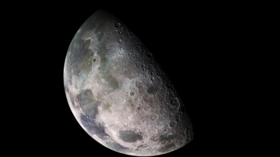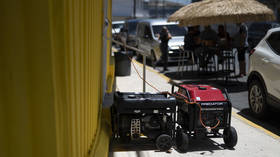NASA to open untouched moon samples for 1st time since Apollo missions (VIDEO)

NASA has selected nine teams to study untouched moon samples brought back to Earth by the Apollo 15, 16 and 17 missions, which have been locked away in storage for the past 50 years.
The teams have been handed a combined budget of $8 million to study the lunar samples in the hopes of deepening NASA’s understanding of the Moon.
“By studying these precious lunar samples for the first time, a new generation of scientists will help advance our understanding of our lunar neighbor and prepare for the next era of exploration of the Moon and beyond,”explained Thomas Zurbuchen, associate administrator for NASA’s Science Mission Directorate.
Military organizations like the US Naval Research Laboratory and academic institutions like the University of Arizona, New Mexico and California Berkeley have been selected to carry out the testing alongside several in-house operations like NASA’s Goddard Spaceflight Center.
Also on rt.com Staggering discovery reveals moon lies INSIDE Earth’s atmosphereWork won’t begin right away, however, as the teams have to discuss how best to open the samples without contaminating them first.
Six of the nine teams will study an Apollo 17 sample core of roughly 1.8lbs of lunar rock layers delivered to Earth by Harrison Schmitt and Gene Cernan in 1972.
The remaining teams will study samples left over from the Apollo 15 and 16 missions that have been frozen or stored in helium since they arrived on Earth.
We need a permanent command and service module around the Moon. We call it Gateway and that’s fully funded in this President’s budget request. - Administrator @JimBridenstine says during #Moon2Mars event pic.twitter.com/83i7xrMJm6
— NASA (@NASA) March 11, 2019
"For the first time in over 10 years, we have money in this budget for a return to the Moon with Humans. I'm talking about human-rated landers to go to the Moon" says @JimBridenstine during #Moon2Mars event pic.twitter.com/UELfW4Gnhq
— NASA (@NASA) March 11, 2019
“Returned samples are an investment in the future. These samples were deliberately saved so we can take advantage of today’s more advanced and sophisticated technology to answer questions we didn’t know we needed to ask,” Lori Glaze, acting director of NASA’s Planetary Science Division, said in a statement.
The teams will study exactly how water is stored in the highly irradiated rock on the lunar surface in an experiment that was begun 50 years ago. They will also explore topics such as space weathering, the geologic history of the Apollo 17 site, and past volcanic activity on the Moon.
Some of the Moon samples collected during the Apollo era were saved so we can take advantage of today’s more advanced technology to answer Qs we didn’t know to ask. Meet the 9 teams selected to continue the science legacy of the Apollo missions: https://t.co/WaAI3N4rTj#Moon2Marspic.twitter.com/4mLPrK935o
— NASA (@NASA) March 11, 2019
Teams will also study the landing site of the Apollo 11 mission to investigate its unique geological characteristics and its potential as a ‘cold trap’ where water may have been able to freeze.
Think your friends would be interested? Share this story!














